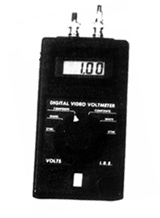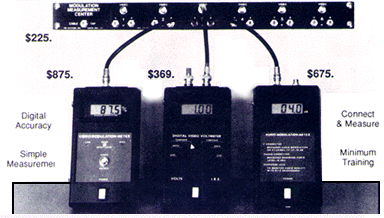FM SYSTEMS’ VVM digital video voltmeter
By Ron Hranac
Senior Technical Editor
Since the introduction of VideoCipher technology for satellite program security and addressable converter operation in systems, our industry has had to pay a lot more attention to baseband signals. RF measurements are no longer the only skills we have to be comfortable with; we now have to understand video, audio and even data signals. More recently, fiber optics has introduced us to the world of lightwave measurements.
Baseband video measurements used to be the exclusive domain of broadcasters, studio personnel and those seeming magicians of long-haul FM microwave. In spite of its relative simplicity, the measurement of video amplitudes has been considered by many to be more difficult than it actually is. But it’s also one of the most important tasks in today’s headends.
While you’re certainly welcome to spend several thousand dollars for a studio-grade video waveform monitor to perform these measurements, the ordinary oscilloscope is quite capable of doing the job. (See “How to set video levels with an oscilloscope,” CT, January 1988.) Now there’s an even easier way to do it: Use FM Systems’ VVM digital video voltmeter. This instrument makes video amplitude measurements as easy as using a digital multimeter to measure voltage or resistance.
The Product
The VVM is a battery operated hand-held instrument that’s just a bit larger than the average hand-held DDM. (See accompanying photo.) It’s housed in a black plastic case that measures 3-13/16 inches wide by 7 inches long (not including switches, knobs or connectors). Since the front of the case is tapered, its thickness ranges from 1-3/8 to 1-11/16 inches. A metal stand is recessed into the back of the case, allowing for convenient tabletop use.
The VVM operates off of a single 9-volt transistor radio battery (alkaline type is recommended) that is accessible through a rear plastic cover. As an option, the meter may be used with a rechargeable NiCd battery that can be charged through a jack provided on the left side of the case. Power is turned on with a front panel momentary contact rocker switch; an automatic off feature turns the VVM off after about one minute of use. The on time can be increased by pushing the switch again before the time-out occurs. Should internal battery voltage be too low to provide accurate readings, internal circuitry prevents the meter from operating when the on switch is pressed.
Video connection to the meter is via one of the two top-mounted BNCs. Like waveform monitors, the VVM incorporates a high impedance loop-through input, so a 75-ohm termination must be installed on one of the connectors if the meter is the last device in the video chain being measured.
The amplitude indication is displayed on a 1-13/16 by 5/8 inch LCD in either volts of IRE units. The user selects one of six measurements with a front panel knob: sync, white or composite peak-to peak voltage; or sync, white or composite peak-to-peak IRE units. Readout resolution is 0.01 volt or 1 IRE unit. The VVM will measure either PAL or NTSC (negative sync) video, and full specifications are in Table 1. List price at the time of the evaluation was $369.

Lab Measurements
I used a Tektronix TSG-100 digital video signal generator as the reference video source, and (to ensure an accurate termination of the VVM’s loop-through input) installed a Tektronix 011-055 precision 75-ohm video terminator on the second connector. To check the meter’s response to various levels of chrominance and luminance content, I measured color bars, a 0 IRE flat field, 50 IRE flat field and an NTC 7 composite signal. Table 2 summarizes waveform monitor IRE unit and peak-to-peak voltage correlations. Since the VVM voltage resolution is 0.01 volt, it rounds off to two places.
|
||||||||||||||||||||||||||
The VVM easily met the manufacturer’s specifications. Table 3 summarizes the meter’s readouts with the various test signals used. The automatic off feature turned the meter off after 1 minute and 2 seconds (this may vary somewhat from unit to unit, depending on factory adjustment). With the meter’s input unterminated, the readings were approximately twice as high as normal, consistent with unterminated oscilloscope or waveform monitor video measurements.
Comments
The VVM digital video voltmeter is an accurate, convenient and low-cost instrument for measuring video signal levels. If you are intimidated by oscilloscope or waveform monitor video measurements, then the VVM will be a useful tool that’s pretty much foolproof to use (just make sure to terminate the output). Furthermore, its low cost makes it particularly attractive for smaller systems.
|
|||||||||||||||||||||||||||||||||||||||||||||||||||||
The instructions that accompany the meter are thorough, including a procedure to set VideoCipher levels. It would be nice if those instruction also included a description of the VVM’s theory of operation and a schematic diagram (that’s a personal preference). As it is, there are not use adjustments for calibration, and if problems occur the meter must be returned to the factory. This isn’t all bad, however; it does prevent inadvertent adjustments that could affect measurement accuracy.
For more information contact
FM Systems at 3877 S. Main St.,
Santa Ana, Calif. 92707;
(714) 979-3355.
TV MODULATION MEASURMENT SYSTEM
SET TV MODULATORS WITH DIGITAL ACCURACY
| DEPTH OF MODULATION | BASEBAND VIDEO LEVEL | AUDIO MODULATION |
| VMM | VVM | AMM |
| The VMM video modulation meter measures depth of modulation in percentage at the 45.75 MHz I.F. output of the TV modulator | The VVM video volt meter measures video baseband sync., white and composite separately in volts peak to peak or I.R.E. units. | The AMM audio modulation meter measures TV audio loudness in db at the 41.25 Mhz I.F. output of the TV modulator |

| VMM | VVM | AMM |
| Video Modulation Meter | Video Volt Meter | Audio Modulation Meter |
Call us with any questions at: 800-235-6960.


